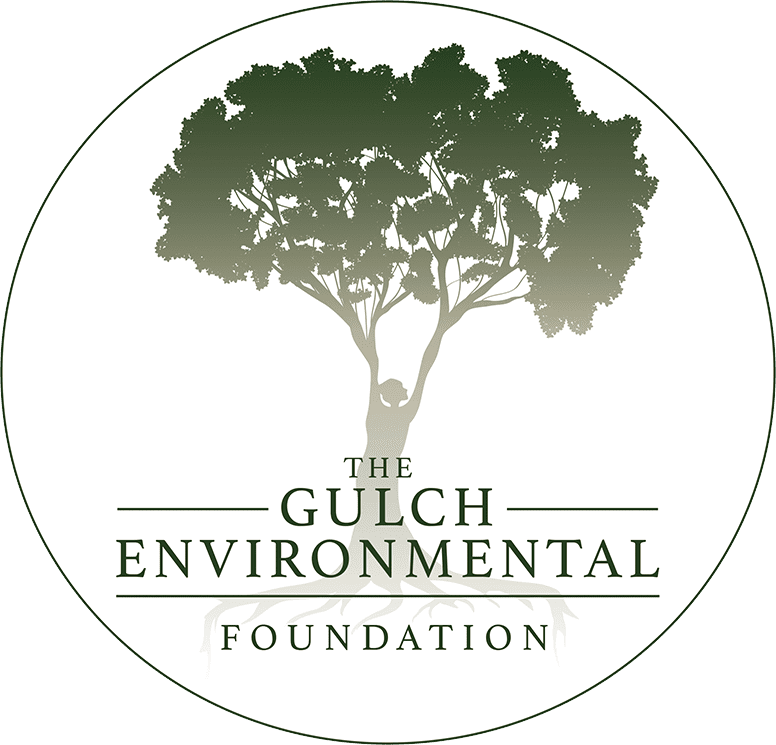2023 Q1 Impact Report
Letter from Founder and Team
Spring is just starting to burst out on the landscape at Rainmaker Farm, our main project in Q1. Just as the honeybees in our hives started their foraging activities again, we have started up our activities on the farm again as well. Despite this quarter being a continuation of the extreme drought conditions in this region, the fruit trees started to bud out and the wheat planted in the fall is turning the fields green. However, we also had a frost that hit just after the early blossoms opened, which was hard on the honeybees and may impact stone fruit harvest this summer. Strong winds impacted the entire region, and due to the drought conditions and tilled fields in the surrounding area, these winds kicked dust visibly high into the air, darkening the sky. Luckily, we have not tilled since owning the property and are using cover crops, securing much of our topsoil. We also moved forward with many other wonderful projects at the farm.
Farm Day 3 was a rousing success. We had 79 people out at Rainmaker Farm for a corporate team building event, representing offices from 8 states/provinces. We threaded the needle of Oklahoma weather possibilities, and it was overall a lovely day – not too hot and not too cold. This Farm Day was extra special, as families were invited, and many people brought their children. These kids worked hard! And their antics made the day incredibly heartwarming. The group accomplished a lot. They learned about community from Angel, soil science from Marty, ecology from Aviva, pollinators and honeybees from Zachary, and cattle ranching from Kellan.

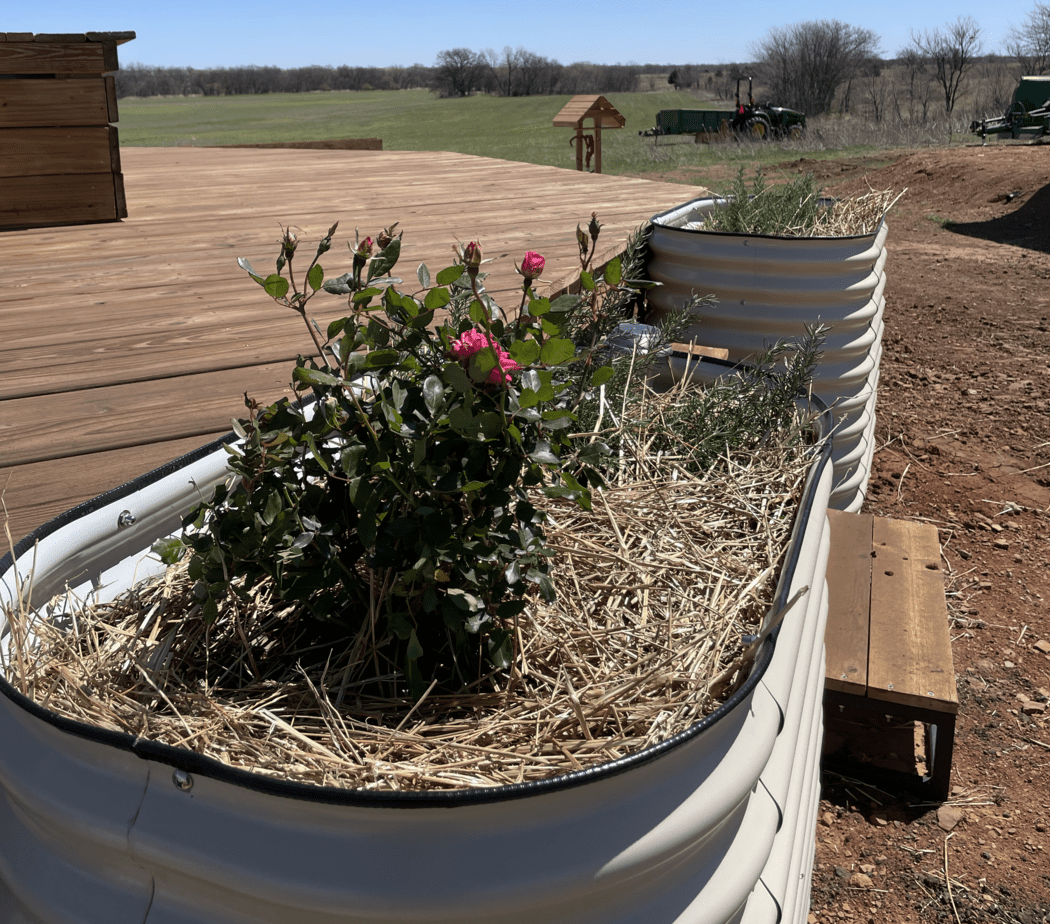
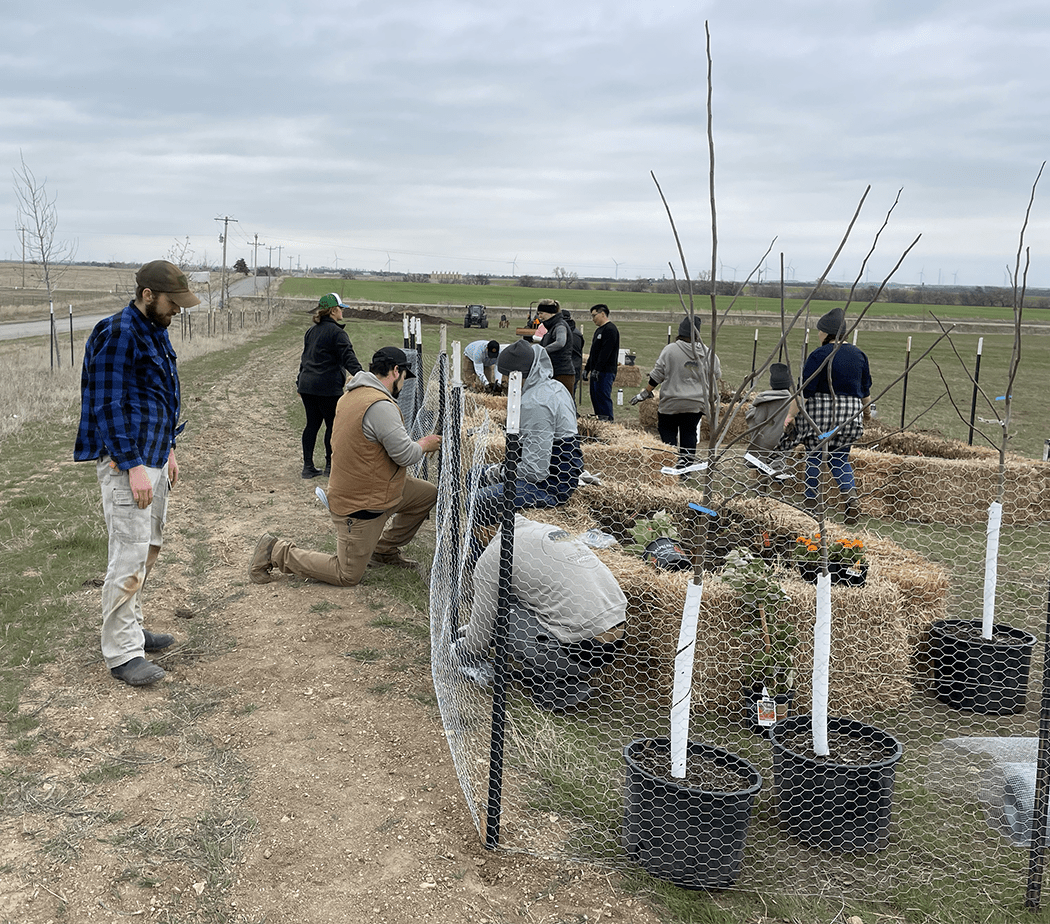
Everyone learned a lot from each other in the process of working together to accomplish a wide variety of tasks for Rainmaker Farm, which are summarized below:
- Built 8 raised beds for around the Tiny House, including re-using the old wood from trees onside for the fill material. Those are now filled with 20 culinary rosemary plants, roses, thyme, and other flowers and fruits.
- Built an enclosed blueberry farm, including raised beds made from straw bales. 40 blueberry plants are now growing, and already providing food for the honeybees and native pollinators, which is critical during this drought.
- Built two beehives from scratch and rebuilt a number of in-use hive frames.
- Built 3 large beds of potatoes.
- Multiple people learned how to drive a tractor and were able to use composted manure to fill the new planting beds, incorporating livestock onto the farm in a way that brings key nutrients back into a cropped system.
- We replaced some trees that did not survive the drought or harsh winters during establishment. We replaced 10 border trees with Oklahoma Redbud, and we the following orchard trees: 5 apple trees, 2 peaches, and a pear in the orchard, and cleared away some pecans in preparation for replacement of those as well.
- Built protective fences around the orchard trees.
- And – a herculean effort went into the build and preparation of our massive new greenhouse, especially getting the foundation trench prepared and the front and back walls built. Kellan and his crew are going to finish building the greenhouse in Q2.
As we move into late spring and summer, we will continue with infrastructure projects, watering the newly planted orchard and blueberries during establishment, and we will continue to develop the farm infrastructure, and continue our outreach, education, and public involvement.
Our projects are working to do good on multiple fronts: carbon sequestration, regenerating soil, make food for those in need, plant diverse crops for stability in changing times, and providing habitat to support our farm as part of the larger matrix of natural systems in the region.
We could not do our work without donors. Our foundation’s administrative costs are covered through sponsorship donations, and all other donations go directly to on the ground project actions.
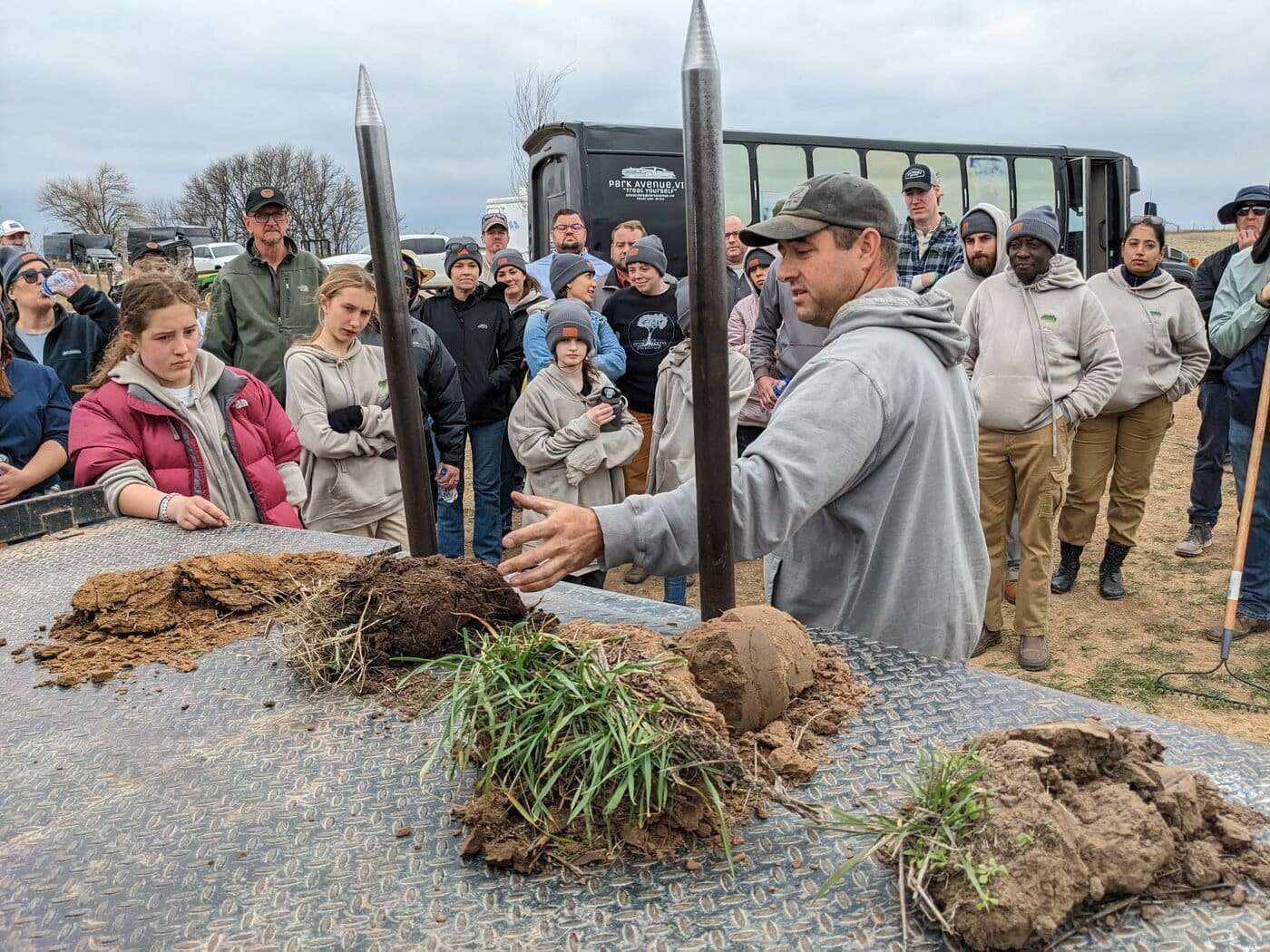
Summary of Q1 Activities
Our donor-funded activities are broken down into 7 main categories. The activities completed during this quarter are outlined below:
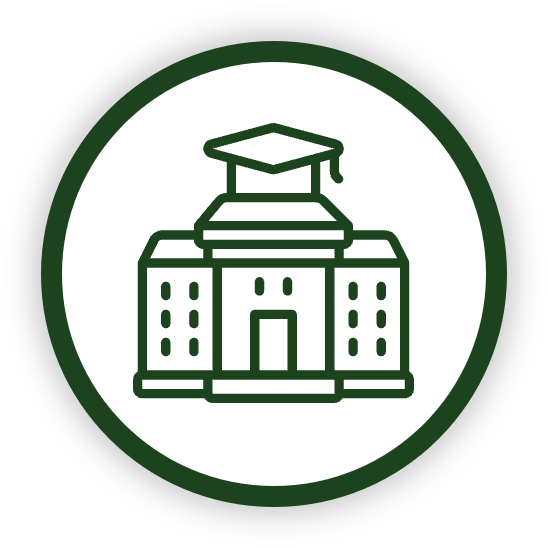
University Involvement Support

Diverse Planting
- Perennial: We continued to care for the orchard trees. There were heavy losses during the vulnerable establishment period due to several hard freezes and the extreme drought, even with supplemental irrigation.
- As part of Farm Day 3, we observed some damage to the trunks of orchard trees over-enthusiastic deer using the young trees as antler scratchers, so we completed protective fencing around the orchard trees.
- Also, as part of Farm Day 3, we installed a blueberry garden with 40 plants.
- Annual: Grain: Planted no-till oats.
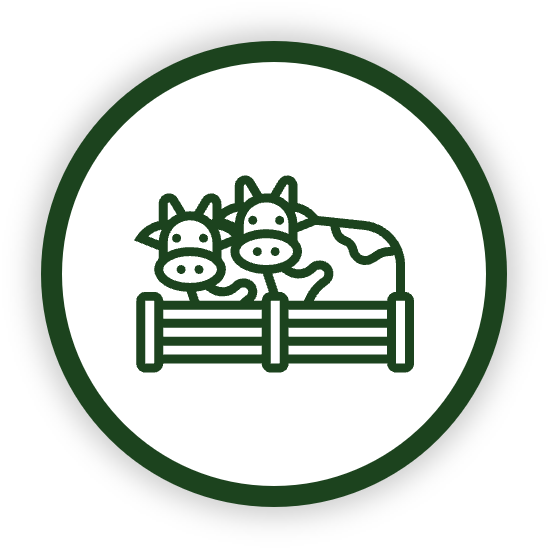
Livestock Incorporation
- Cattle: As part of indirect incorporation of livestock, Rainmaker purchased 220 tons of composted cattle manure from a nearby cattle rancher to use as fertilizer. This will be spread across all fields in Q2. Some of the cattle who were at Rainmaker to help control thatch in the grassland area liked it so much here, they escaped after being moved and made their way back! They then stayed a bit longer to be animal ambassadors for Farm Day.
- European Honeybees: Q1 was a difficult start for our honeybees. Initially the hives appeared to have weathered winter reasonably well, and we were able to harvest approximately 12 ounces of honey before foraging began. However, shortly after they began spring foraging, a hard freeze hit the region which devastated flowering plants. That combined with the ongoing drought did result in the loss of another hive. We will be requeening and renewing these hives once the rain starts again and they have a decent chance of thriving.
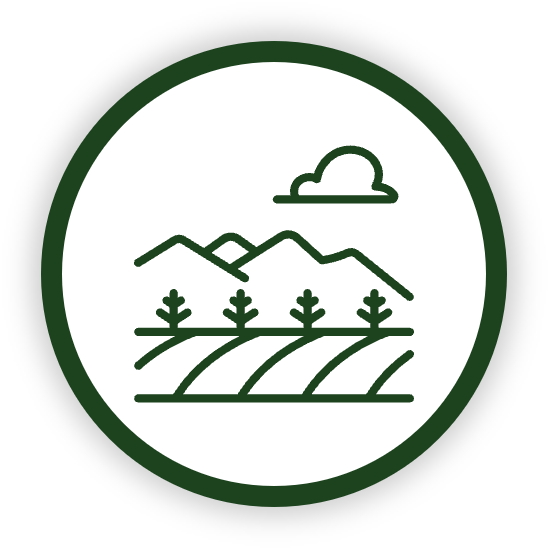
Cover Cropping
- Cover cropping is beneficial to regenerative farming in many ways. It protects the soil from erosion. Many species replenish essential nutrients, such as nitrogen, in the soil. The deep roots from native species also help sequester carbon. Our native grass cover crop will continue to develop around the orchard, which will help with carbon sequestration, soil stabilization and retaining water in that soil. All fields are planted with either annual or perennial cover.

Farm Equipment & Supplies
- Rainmaker farm upsized tractors to one that will allow us to haul farming equipment. We also obtained a manure spreader, conservation seeder, gator, and batwing brush mower.
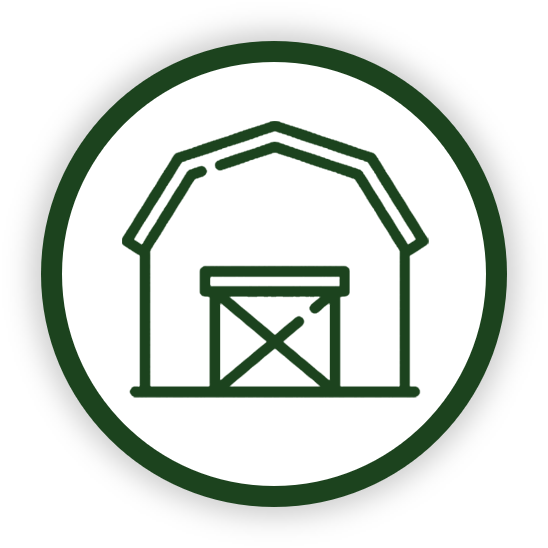
Infrastructure
- We are moving forward with water catchment, using structures on the farm. However, we determined that a solar well is not feasible due to lack of groundwater.
- The barn now has electrical run to it, with counter height outlets throughout, as well as 4 external outlets.
- Assembly began on the greenhouse, the team at Farm Day 3 worked incredibly hard to dig out the foundation trenches and get the foundation frame in. Assembly will be completed early in Q2.
- 9 raised beds were built using 100 straw bales as siding material.
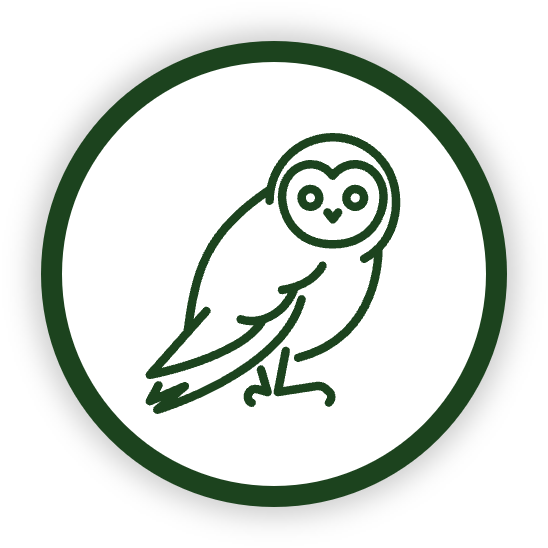
Rainmaker Farm
- Ongoing monitoring of the Barn Owl Nest boxes Rainmaker Farm is using ecological pest management. One box shows signs of use (substantial whitewash inside), but no nesting yet.
Targets and Goal Tracking
We are on track to meet our targets and goals.
Next Steps
In Q2 2023 we anticipate the following:
- Completion of greenhouse build.
- Manure application throughout all crop fields.
- Sunflower planting around perimeter.
- Continue to care for the orchard and border trees, including watering new plantings.
- Watering blueberry garden.
- Start preparing the infrastructure for goats, which will help with invasive species control, nutrient cycling, and food production.
- Developing additional water sources (water catchment).
- Explore partnering with a pollinator researcher.
- Continue our outreach and education efforts.
- Additional mulch for barn owl boxes to encourage nesting use.
